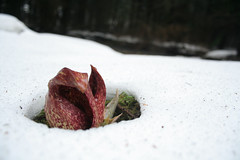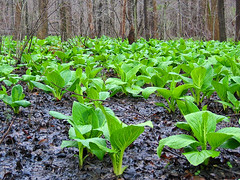 Skunk-cabbage (Symplocarpus foetidus) is one of the few plant species that exhibits thermogenesis - generating temperatures much higher than its surroundings, allowing it to flower earlier in the season that almost any other plant.
Skunk-cabbage (Symplocarpus foetidus) is one of the few plant species that exhibits thermogenesis - generating temperatures much higher than its surroundings, allowing it to flower earlier in the season that almost any other plant.
Photographer: Flickr user Ryan JohnsonFound in wetlands, skunk-cabbage (Symplocarpus foetidus) is a common plant at Rock Creek Park, with most unusual characteristics. It grows where the temperature near the soil surface is regulated by the year-round discharge of groundwater, which holds a constant temperature of 55° F (13° C). The hooded maroon and sometimes green-striped spathe is the first part of the plant to emerge, and encloses the knob-like flowering structure called the spadix. The hooded design of the thick, fleshy spathe traps the latent heat released by the groundwater, which is one reason this plant is often seen flowering during the chilly days of late winter, when everything else is still dormant. The ability to influence its own microclimate is further enhanced by the extraordinarily fast metabolism of this plant. Skunk-cabbage actually produces sufficient heat to melt snow and ice around the base of the plant! Some of the season’s earliest insects find haven in this plant’s warm hood.
 Skunk-cabbage (Symplocarpus foetidus) in early summer.
Skunk-cabbage (Symplocarpus foetidus) in early summer.
Photographer: Gary Fleming.Skunk-cabbage does not tolerate high temperatures well, yet grows vigorously until mid-summer. Why? The groundwater also “air conditions” its habitat during these hot months. Skunk-cabbage is one of the most prominent examples in the park of a beautifully fine-tuned relationship between a plant and its specific ecological niche. At Rock Creek Park, skunk-cabbage is often found in the groundwater-influenced Red Maple Seepage Swamp.


